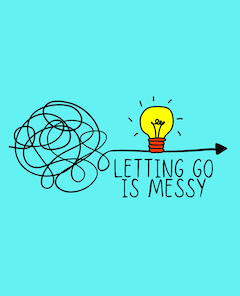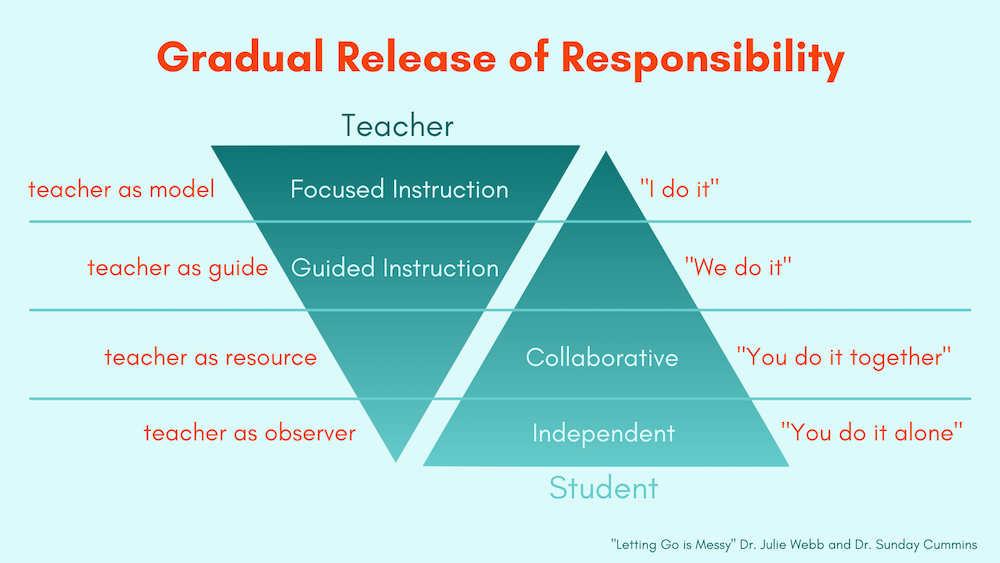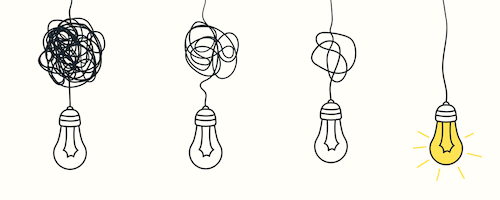Teachers Are Active in Every Phase of GRR
A MiddleWeb Blog
Literacy coaches Sunday Cummins and Julie Webb are back with the second post of their new blog, Letting Go Is Messy, a year-long look at the challenges of making the Gradual Release of Responsibility part of our everyday practice.
By Sunday Cummins and Julie Webb
In our first post we compared the use of GRR in our classrooms with teaching a child to ride a bike. The analogy works, but only up to a point.
In this second post we dive a little deeper and think about the critical roles teachers play at every step when we begin to implement the Gradual Release of Responsibility framework.
In the GRR model, the work of learning shifts from teacher-driven to student-driven in phases. Teaching experts Douglas Fisher and Nancy Frey (2008, 2019) outline the phases this way:
- Focused instruction – I do it (the teacher)
- Guided instruction – We do it (teacher & student)
- Collaborative – You (students) do it together
- Independent – You (the student) do it alone
Sometimes teachers get the mistaken impression that when responsibility for learning shifts to students the teacher no longer plays a significant role in the learning process. But the teacher’s role doesn’t diminish during GRR. It transforms to better match the current learning context.
This transformation is made strategically and purposefully as the teacher determines student needs. As we show in our infographic below (click to enlarge), if we reframe the model to better depict the teacher’s active role in GRR, we see:
- Teacher as model
- Teacher as guide
- Teacher as resource
- Teacher as observer
What does this look like in practice?
Take a 4th grade writing lesson as an example. Prior to the lesson, the teacher notices students are struggling with personal narratives, specifically that the student’s pacing of the narratives leads to some important sections of their work being underdeveloped.
The teacher decides a graphic organizer could help support students. In a follow-up lesson, she introduces the concept to students and models for them how she would map her own imbalanced writing sample onto the graphic organizer, thereby revealing where the piece needs improvement.
She then asks students to repeat the process using their own work. As they do, she checks in with individual students offering feedback and support. At the end of the lesson, students explain the content of their graphic organizers to a peer and discuss ways they might improve their pieces tomorrow. The teacher leans in to listen to groups, observing and only offering support as needed.
In this sample lesson, the teacher assumed several roles during GRR. She first acted as a model, demonstrating and explaining for students. Then she shifted to a guide, supporting individuals as they made their own attempts. Finally, she became a resource and gradually more of an observer, listening and providing the least support necessary as students worked collaboratively.
During follow-up lessons or units of study, as this teacher’s writing students gain more mastery with the concept of pacing, she will continue to act as an observer and resource, supporting students on an as-needed basis and providing tools like graphic organizers only when needed.
Gradual Release behind the scenes
Releasing responsibility to students may appear seamless on the surface, but the teacher is doing a lot behind the scenes to manage the process. In our 4th grade writing example, the teacher first carefully analyzed her students’ work so far and their current needs.
As she planned the lesson, she considered which supports would work best (in this case a graphic organizer). She made in-the-moment decisions about how much modeling and guidance to provide, observing students carefully, noting their progress.
Finally, she weighed all of this information to determine how to proceed the following day and in subsequent lessons. She continually thought about when and how to shift the cognitive load from teacher to student, adding and removing supports along the way to achieve the best balance in the circumstances.
As teachers we know this stuff isn’t easy. In fact, it’s downright messy. That’s what this blog is all about. Rolling up our sleeves and digging into the beautiful messiness that is teaching and learning.
Fisher, D., & Frey, N. (2008). Better learning through structured teaching: A framework for the gradual release of responsibility. ASCD.
Fisher, D., Frey, N., & Akhavan, N. (2019). This is balanced literacy, grades K-6. Corwin.
Sunday Cummins, Ph.D, is a literacy consultant and author and has been a teacher and literacy coach in public schools. Her work focuses on supporting teachers, schools and districts as they plan and implement assessment driven instruction with complex informational sources including traditional texts, video and infographics. She is the author of several professional books, including Close Reading of Informational Sources (Guilford, 2019). Visit her website and follow her on Twitter @SundayCummins. See her previous MiddleWeb articles here.










































Hi, Sunday and Julie–I appreciate this multi-part blog about GRR. Possibly you were planning to bring this up, but I would just like to add that in my observation, teachers sometimes mistake “I Do” for “I do while you silently/passively watch,” and I think we need to clarify that “I Do” is more “I do and ask questions to check for understanding as I model.”
Agreed! We’d add that many times teachers do too much “I do” before drawing students into the “we do.” Can’t wait to write about this. Thank you for your encouragement.